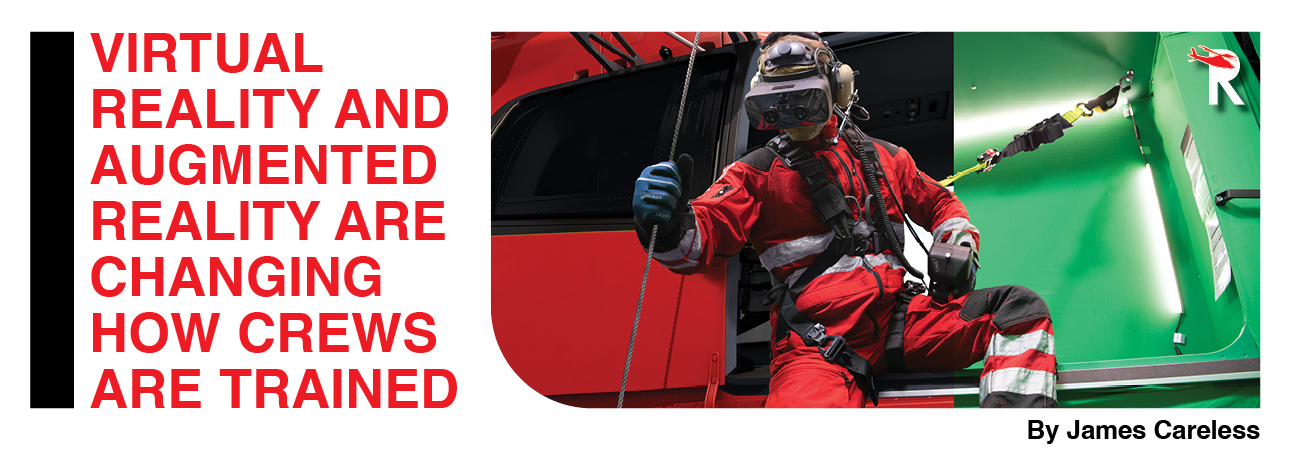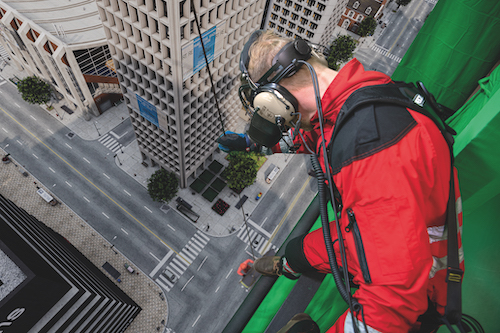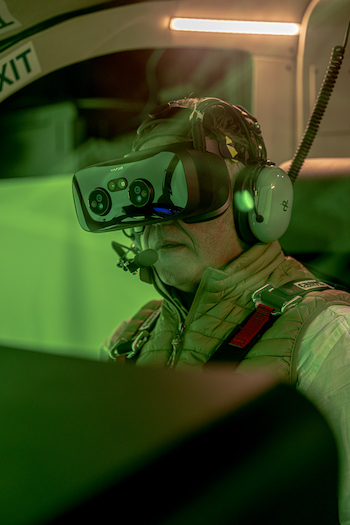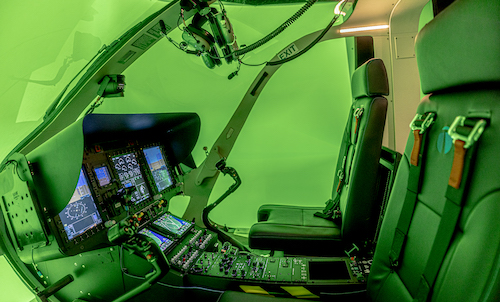|
Jun
17
2024
|
|
Posted 1 years 215 days ago ago by Admin
|
|

There’s a revolution taking place in pilot training, thanks to VR (virtual reality) and AR (augmented reality; also known as mixed reality or MR). Both offer computer-assisted ways to make pilot training safer both on the ground and in flight. In doing so, these technologies make it possible for student pilots to gain relevant skills before they ever go aloft, and to receive training assistance once they are in the cockpit and flying for the very first time.
“Virtual reality or VR replaces the real world with a virtual world,” said Martin Keil, CTO at Reiser Simulation and Training, a German manufacturer of Level D full flight simulators that has added VR to its training portfolio. “augmented reality (AR) combines the virtual world with real world elements, offering the possibility of creating new, highly immersive training environments.”
A Quick Tech Primer
Here’s the rule of thumb for VR versus AR training. VR training is usually done on the ground with the student wearing ‘VR goggles’ (aka headsets) that encase their eyes and cut off the outside world.
To convey realistic moving images to the wearer, “VR goggles contain a light LED screen and two lenses that distort the image so that it appears to be in three dimensions,” said Nacho Navacerrada, sales director at the flight simulation company Entrol. “The sensors located in the VR goggles track the position of the user’s head to coordinate what is being projected, providing the illusion of being immersed in another world.”
In contrast, “AR headsets superimpose computer-generated imagery onto the real world,” Navacerrada said. “For example, pilots can see a procedural flow superimposed on the cockpit’s control surfaces.”
When it comes to rotorcraft flight education, “AR and VR are great tools for Autorotation and Hovering training, as you can look down and have a better perception of the terrain reference,” said Navacerrada. “Additionally, you can use VR goggles to train rear crew members such as hoist operators, doctors, and landing coordinators so that they can train in the same training environment to practice communication and phraseology, one of the keys for a successful and safe mission.”

This last approach is used by Bluedrop Training and Simulation to train helicopter hoist operators. “VR/MR simulation technology adapts readily to SAR training, and the latest high-fidelity tech has the potential to revolutionize rear crew training,” said Jean-Claude Siew, Bluedrop’s EVP of Technology and Simulation. To make this process more realistic and useful, Bluedrop’s rear crew training takes place in a physical shell that includes actual controls and devices that the student can interact with, as displayed to them in VR/MR.
AR/VR Training Sources Worth Knowing
As mentioned above, Entrol sells VR flight training systems. The company also combines mixed reality (MR) goggles with direct projection. “For example, one pilot can wear the MR goggles for the VFR mission part, having a 360-degree field of vision, while the other pilot uses the spherical visual with projectors to focus on the cockpit monitoring and systems,” he said.
Bluedrop is focused entirely on non-cockpit VR/MR training aided by physical training environments and control devices. For example, this company’s “Hoist Mission Training System” (HMTS) is a fully immersive VR training enclosure for external load hoisting operations. Meanwhile, Bluedrop’s Multipurpose Gunnery Mission Trainer (MGMT) allows a student to
practice aerial gunnery skills in a VR/MR world that looks, sounds, and even feels real, but is not.
Having provided VR and AR/MR helicopter training to military clients for years, TRU Simulation has recently moved into the civil/commercial side of the business with its TRU Veris VR simulator. Veris combines VR goggles with a pilot chair and physical controls inside a physical cabin that moves like a full flight simulator (FFS).
TRU Simulation unveiled the Veris at HAI Heli-Expo 2024, with Bell as its launch customer for the Bell 505 platform. “The Veris can support both VR training and AR training for the civil and commercial space,” said Jerry Messaris, TRU Simulation’s general manager.
Queppelin has developed a flight simulation platform that can be customized for various aircraft, helicopters and drones. “The platform allows changing the terrain and environment as well as the cockpit controls according to the aircraft type and model,” said company co-founder and CEO Pulkit Mathur. “Pilots need a virtual reality or augmented reality headset to train themselves using Queppelin's simulators. These headsets include Quest, Apple Vision Pro and others.”
Reiser’s first product in VR was the third crew member station on the Airbus H145 FFS simulator at Norwegian Competence Center Helicopter in Stavanger, Norway,” said Keil. “While the flight crew uses the FFS visual system, the third crew member’s outside view is provided by see-through AR goggles.” The latest Reiser product is the hoistAR mobile hoist training simulator. It allows students to train in a safe, yet highly realistic environment.

Entrol's H145 simulator incorporates virtual and mixed - reality into the training system.
Vrgineers is a maker of high-quality AR/VR XTAL headsets (aka goggles) and related cockpit replica simulation systems. “Thanks to the possibility of interconnection, it is possible to train not only pilots but also the cooperation of a pilot with a co-pilot, a gunner with a pilot, JTAC instructors, and the coordination of entire squadrons,” said Marek Polcak, Vrgineers’ CEO. “Vrgineers’ simulators support both Western and Eastern aviation platforms, from propeller-driven to subsonic to supersonic aircraft and helicopters.”
Power and Space Required
As cool as these VR/AR training systems are in their own right, some of them need supporting infrastructures to be used as training aids. So, we asked the suppliers cited above what extras might be required to make them work.
For Entrol’s training solution, all you need is “a good set of VR/MR goggles — currently, we use Varjo models — and a powerful computer to run the simulator,” Navacerrada said. “With MR, you also need to develop the interaction between the MR and the hardware, which can be made with Chroma Keys or by masking the real object.” The same is true for the AV/VR systems made by Queppelin and Reiser.
Bluedrop’s training systems, which are mostly for marine applications, come complete with everything needed in their physical training modules. If the notion of buying a trainer for marine applications seems unnecessary for a land-based search-and-rescue operation, think again: “Nearly 70% of SAR missions take place in a marine environment, where the hoist rescue is often accomplished using complex procedures and equipment amid wind, rain, spray, and rotor wash and locations such as a sinking vessel with many snag points for the hoist cable,” said Siew.
TRU Simulations’ Veris also needs power and space for itself and its instructor station, but that’s it. “TRU has decades of experience building Level-D simulators and flight training devices, which is the highest level of training that you will see in the commercial space,” Messaris noted. By using VR in the Veris, TRU has created a cost-effective, high-fidelity training device “that has a much smaller footprint, something that could be supported now in a 10-foot by 10-foot space,” he said. In contrast, “a traditional full flight simulator may need a 40-foot by 40-foot high bay to support a device.”
As for Vrgineers? “To use Vrgineers’ XTAL system, you need the XTAL headset and Vrgineers Simulator, as well as simulation software and motion-tracking system,” said Polcak. Power and floor space for it and the instructor’s station are also required.
Benefits and Limits
When it comes to the benefits of VR/AR training versus traditional training, cost is the big advantage. “Synthetic training will always help to reduce the operator's cost by using the simulator instead of the real helicopter,” Navacerrada said.
Messaris agreed that cost is the big one but added that VR and AR “create a very real and immersive environment,” he said. The trainee has the “ability to really see 360 degrees both horizontally and vertically.”
Smaller VR/AR training devices are less costly than traditional FFS training systems, said Keil. “This makes them affordable for smaller operators, while reducing the need to travel to training centers that operate classical types of training devices.”
“VR can reduce the amount of actual reflights,” added Polcak. “It allows pilots/cadets to train without the limitation of physical simulator availability.”
“Pilots get an instant assessment using VR simulations,” Mathur said. “This allows them to review their performance and identify areas for improvement.”

Entrol's H145 simulator incorporates virtual and mixed - reality into the training system.
This being said, there are times that VR/AR training cannot replace the real thing. For instance, even with the best haptic controls and full motion platforms, sometimes an actual cockpit is the best place to teach students what’s what.
The sophistication level of VR/AR technology can be a limiting factor as well. “It depends on the sensors and capabilities of the headset,” said Messaris. Weight can also be a factor. Today’s hefty goggles are not slick pairs of lightweight glasses that one sees in the movies.
In addition, simulated controls may lack the heft of their real-world counterparts “Most existing cable simulations are either an elastic band or a cable with only up-down movement and fixed tension,” said Siew.
Other limits depend on the type of training being done and its content. “For example, while the crew can wear actual night vision goggles (NVGs) in a classic training FFS, the use of night vision goggles must be simulated on VR training devices, as you can only wear VR goggles or NVG goggles,” Keil said.
Finally, there’s the psychological differences between VR/AR training and in-flight instruction. “Despite their immersive nature, VR simulations may not fully replicate the psychological stress and fatigue of a real flight operation,” said Mathur.
Yet even when taken as a whole, these limits do not denigrate the overall value of VR/AR training for pilots. They simply make the point that VR/AR training — useful as it is — is only a part of a total training approach that still requires students to spend time in the air.
As for the future? Expect the weight and limitations of today’s VR/AR systems to go down, while the clarity, resolution, and capabilities of these systems go up. “The resolution will get better, along with the eye tracking,” Navacerrada said. This will make VR/AR even more integral to pilot training — but never a complete substitute for actual flight.
READ MORE ROTOR PRO: https://justhelicopters.com/Magazine
WATCH ROTOR PRO YOUTUBE CHANNEL: https://buff.ly/3Md0T3y
You can also find us on
Instagram - https://www.instagram.com/rotorpro1
Facebook - https://www.facebook.com/rotorpro1
Twitter - https://twitter.com/justhelicopters
LinkedIn - https://www.linkedin.com/company/rotorpro1